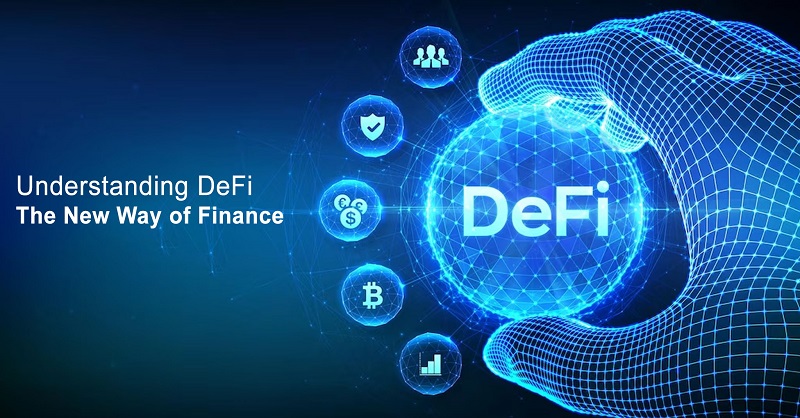
November 04, 2025
Decentralized Finance (DeFi): Harnessing Blockchain for Transparent and Resilient Financial Systems
Decentralized Finance (DeFi): Harnessing Blockchain for Transparent and Resilient Financial Systems
Have you considered a financial system without banks or middlemen? What if you could originate and handle financial transactions online without centralised institutions? Sounds like a dream. Welcome to Decentralised Finance (DeFi), a blockchain software redefining money, finance, and transactions. In this post, I'll explain how DeFi is changing finance, why developers care, and how to build dApps on blockchain. Ready to know?
What is Decentralised Finance (DeFi?
Decentralised Finance (DeFi) refers to blockchain-based financial services. Instead of banks and centralized entities, DeFi uses smart contracts on blockchain networks like Ethereum to function without middlemen. Third parties will no longer approve transactions, administer loans, or facilitate trade.
Financial transactions between DeFi members are recorded on an immutable ledger using blockchain technology. App developers can make tools that help people handle their finances better. Without a single authority, blockchain handles everything in a safe and public way.
How does this affect financial systems? Let's examine DeFi's basic components and how developers can use it.
Core Components of DeFi
Tell me what makes DeFi tick.
- Smart Contracts: are the foundation of any DeFi application. Smart contracts are coded agreements that self-execute. Immutable blockchain contracts cannot be changed once executed.
- Decentralised Exchanges (DEXs): DEXs enable direct cryptocurrency trading without centralised exchanges like Coinbase. Leading secure, trustless trading platforms include Uniswap.
- Lending & Borrowing Platforms: You may lend and borrow money on DeFi without a middleman and earn interest. Aave and Compound are famous crypto lending services for passive income.
- Stablecoins: DeFi employs DAI or USDT, tethered to a fiat currency (e.g. USD), to reduce crypto volatility.
These parts are developer playgrounds. So, how can you develop with them?
How Blockchain Ensures Transparency and Resilience in DeFi?
DeFi lets us investigate blockchain's possibilities. Blockchain's resilience and transparency are significant. All blockchain transactions are public and immutable.
This clarifies transactions so you can follow your money and know what's happening. Transparency is used on DeFi systems to stop fraud and manipulation.
Because the blockchain is irreversible, transactions are permanent. Avoiding centralized servers that may fail or be hacked makes DeFi systems resilient.
A simple DeFi lending system smart contract code example:
pragma solidity ^0.8.0;
contract SimpleLending {
mapping(address => uint) public balances;
function deposit() public payable {
balances[msg.sender] += msg.value;
}
function loan(uint amount) public {
require(balances[msg.sender] >= amount, "Insufficient funds");
payable(msg.sender).transfer(amount);
}
}This contract shows how events on the blockchain let people make transactions without having to trust each other. The user's amount fluctuates, and lenders arrive instantly.
The Benefits of DeFi for Developers
Developers might ask: Why work with DeFi? Let's talk about its important benefits.
- Innovation: DeFi gives coders and developers a huge range of options. Lending platforms, DEXs, and automatic ways to trade can be made even if there aren't any set systems in place.
- Lower Barriers to Entry: DeFi lowers entry barriers by eliminating intermediaries, enabling participation for anybody with an internet connection. Finance becomes available to millions of unbanked individuals.
- Global Reach: Blockchain-based DeFi applications are borderless and global. Regardless of geography or currency, developers can create apps that anyone can use.
- Profit from Innovation: Developers can monetise DeFi apps through liquidity pools, staking, or token creation. They may earn passive income by providing liquidity or building yield-generating products on DeFi.
Also DeFi gives coders a lot of chances to work in the blockchain field, which is growing quickly. So, are you ready to start building creative apps? Find out how to code and get some tools.
How Developers Can Build Scalable DeFi Applications
Scalable DeFi apps need special care. Fuel fee smart contracts should be optimized to reduce transaction costs. Use Layer 2 solutions like Optimism or Polygon to scale your app without increasing costs.
Developers should test smart contract deployment using Truffle or Hardhat. These tools enable you test code on local blockchains before launching. Audit your contracts to prevent vulnerabilities, security is essential.
Using Web3.js to deposit transactions to a smart contract:
const Web3 = require('web3');
const web3 = new Web3('https://mainnet.infura.io/v3/YOUR_INFURA_KEY');
const contractABI = [...]; // ABI here
const contractAddress = '0x...'; // Contract address
const contract = new web3.eth.Contract(contractABI, contractAddress);
async function deposit(amount) {
const accounts = await web3.eth.getAccounts();
await contract.methods.deposit().send({ from: accounts[0], value: web3.utils.toWei(amount, 'ether') });
}
deposit('1'); // Deposit 1 etherYou can communicate with your DeFi contract with this code to optimize your app.
Conclusion
DeFi is transforming finance, not just a trend. Developers can design transparent, safe, and innovative apps with DeFi. Learn smart contracts, blockchain, and DeFi protocols to construct future financial systems.
64 views
